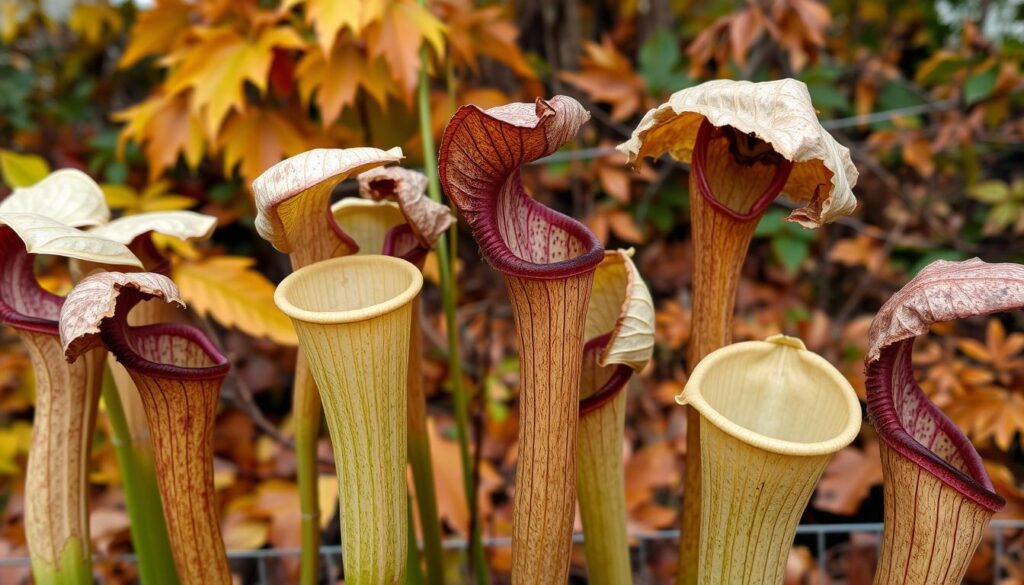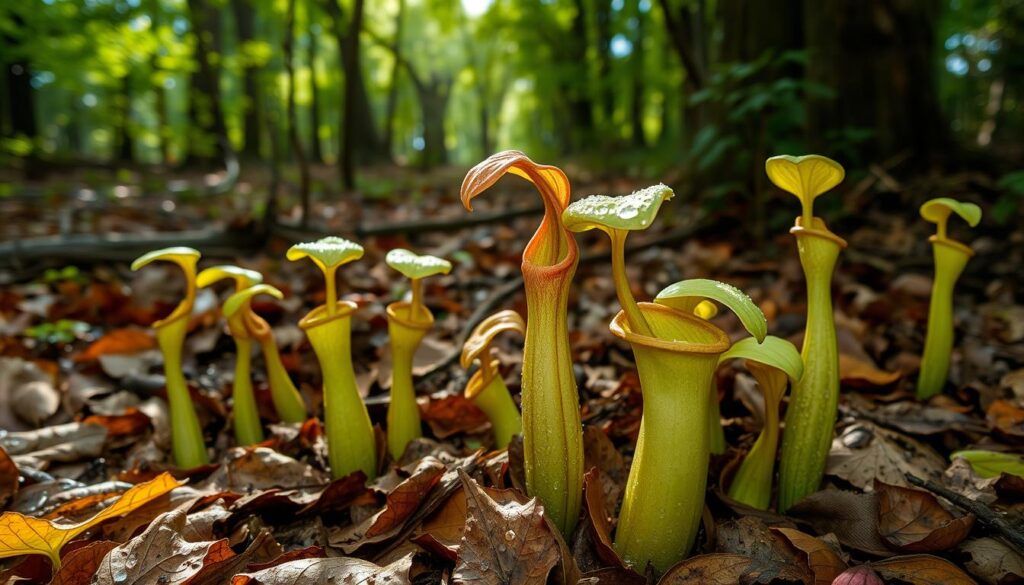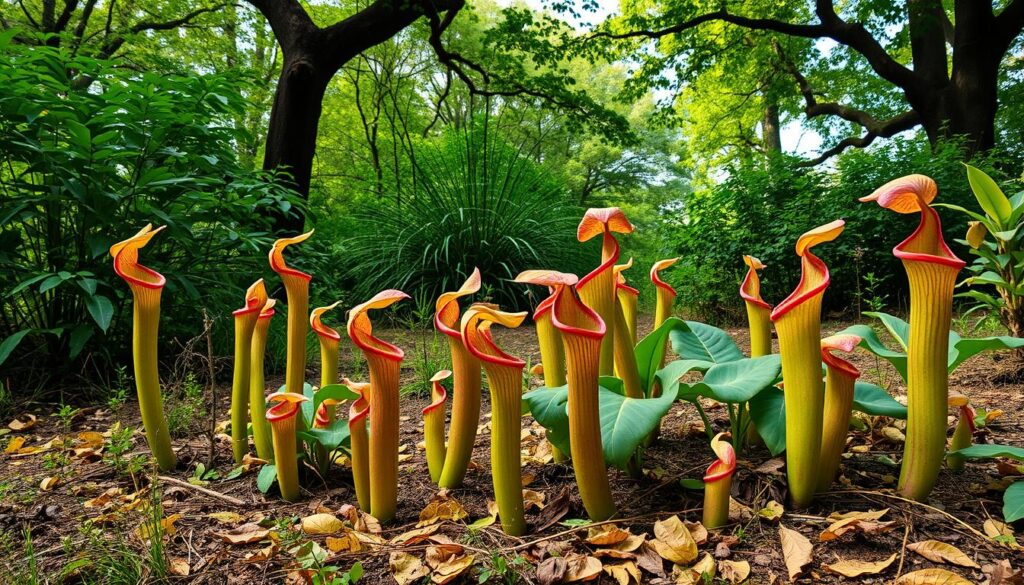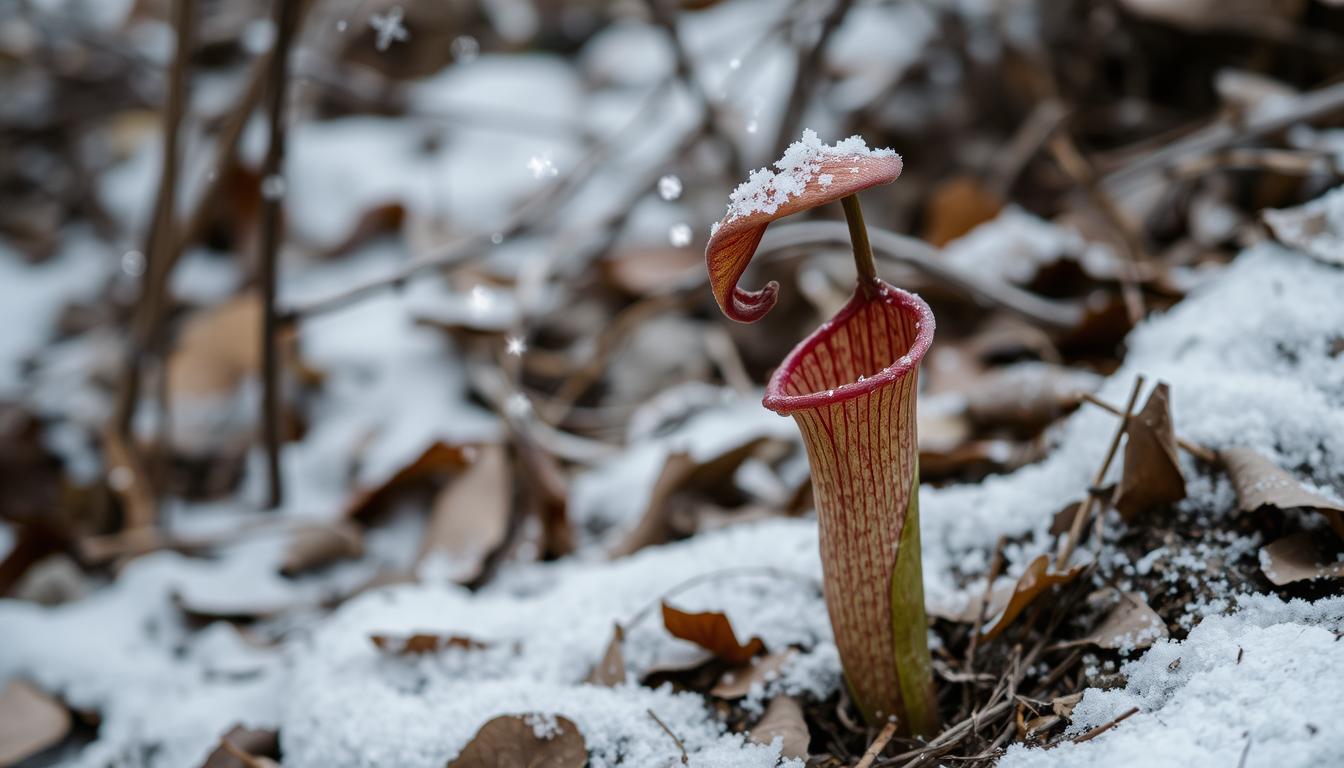Understanding pitcher plant dormancy is crucial for dedicated gardeners and plant enthusiasts. Pitcher plants, especially those from the Sarracenia genus, enter a state of dormancy to help conserve energy during colder months. This phase sees a significant reduction in metabolic activity, which is essential for the health of a dormant pitcher plant. Without the right dormant conditions, these plants face risks of poor growth and potential death. This article outlines key aspects of pitcher plant dormancy, including signs of dormancy, ideal conditions, and preparation steps to promote healthy growth during this vital phase.
Many dedicated gardeners wonder, do pitcher plants go dormant? The answer is affirmative, as they typically require a dormancy period of 5 to 6 months in non-tropical climates. Recognizing and facilitating this process is vital for a thriving garden of these unique plants.
Table of Contents
Key Takeaways
- Pitcher plants require dormancy to conserve energy and maintain health.
- Signs of dormancy include reduced growth rates and yellowing leaves.
- Ideal conditions for dormancy include cool temperatures and specific humidity levels.
- Different Sarracenia species exhibit varied dormancy patterns.
- Proper preparation before dormancy is crucial for successful reawakening.
- Understanding dormancy can prevent common horticultural challenges.
Understanding Pitcher Plant Dormancy
Understanding pitcher plant dormancy is essential for successful cultivation and care. This period of rest allows these fascinating plants to cope with environmental changes. Each species of pitcher plant, particularly those in the genus Sarracenia, follows a unique path in its life cycle, which includes dormancy as a vital phase.
What is Dormancy?
Dormancy is a natural protective mechanism that enables plants to survive during unfavorable conditions. During this time, growth slows significantly, metabolic processes diminish, and the plant conserves energy. For many pitcher plants, dormancy typically occurs in winter, lasting around 3 to 4 months. This period is especially crucial for mature plants, as it rejuvenates their growth potential for the upcoming season.
Why Do Pitcher Plants Go Dormant?
Pitcher plants go dormant primarily to withstand cold temperatures and reduced light availability. In USDA hardiness zones, species such as Sarracenia purpura exhibit cold-hardiness, surviving in temperatures as low as 45°F (7°C). Dormancy is crucial for nutrient conservation, helping plants adapt to environmental changes. Young plants may not need dormancy, though established varieties thrive with this resting phase.
The Life Cycle of a Pitcher Plant
The life cycle of pitcher plants involves several stages influenced by seasonal changes:
- Growth Phase: During warmer months, pitcher plants flourish, producing vibrant traps and absorbing nutrients.
- Dormancy: In winter, the plants halt growth, entering a period that conserves energy and prepares for the next growth cycle.
- Revival: As temperatures rise and daylight increases in spring, plants awaken from their dormancy, resuming active growth.
Understanding these stages empowers plant enthusiasts to better care for their pitcher plants, ensuring they thrive year after year.
Signs of Dormancy in Pitcher Plants
Understanding the signs of dormancy in pitcher plants enhances the ability to care for these unique species during their seasonal cycle. As these plants enter a dormant state, they exhibit several notable characteristics that indicate a shift in their growth and health. Awareness of these signs ensures proper attention and care during this critical period.
Yellowing and Wilting Leaves
One prominent sign of dormancy is the appearance of yellowing leaves. As temperatures drop, the plant redirects its energy away from the foliage. Wilting may also occur, indicating stress as the plant prepares for a period of low activity. Observing these symptoms is essential, as they typically signal an impending dormancy phase.
Decreased Nectar Production
Another telltale sign of dormancy is decreased nectar production. This reduction suggests that the plant is no longer actively hunting for insects. A decline in nectar not only affects the plant’s insect-trapping capabilities but also indicates that it is conserving energy for the dormant season.
Reduced Growth Rate
As the seasons change, a noticeable reduction in growth rate becomes evident. The plant may seem stagnant, with little to no growth taking place. Gardener observations should include monitoring for any new leaves or traps, as these typically stall significantly during dormancy. Pitcher plants may appear particularly shrunk, with new growth resuming only once environmental conditions become favorable again.

Ideal Conditions for Dormancy
Creating the ideal conditions for pitcher plant dormancy is crucial to their survival and health. For temperate carnivorous plants, specific environmental factors must be maintained to facilitate a successful dormancy period. This section discusses the temperature requirements as well as suitable light and humidity levels that support these plants during their dormant phase.
Temperature Requirements
The temperature requirements for pitcher plants during dormancy can vary based on species. Generally, a cool range between 45°F to 50°F (7°C to 10°C) is optimal. A dormancy period lasting a minimum of 45 days at these temperatures is essential. As the temperatures drop, the plant undergoes physiological changes, allowing it to conserve resources during the colder months.
Light and Humidity Levels
Light and humidity for dormancy play a significant role in maintaining the health of pitcher plants. Even though light levels tend to decrease, providing some indirect light is essential. A photoperiod of around 8 to 10 hours during winter supports the dormancy process. The decreased light intensity, alongside cool temperatures, signals the plants to enter dormancy.
Maintaining moderate humidity is equally important. Humidity levels should be monitored to ensure that the plants do not dry out during this period. This balance between light and humidity is important to achieve the ideal conditions for pitcher plant dormancy.
For detailed information regarding dormancy guidelines, consider referring to available resources on plant care, such as dormancy in carnivorous plants.
Preparing Your Pitcher Plants for Dormancy
Proper preparation of pitcher plants dormancy is crucial for their health and longevity. As seasons change, adjustments in care become necessary, particularly concerning water management, pruning, and fertilization. Following these steps helps ensure that the plants remain robust through their inactive phase.
Managing Water Levels
In preparing pitcher plants dormancy, managing water levels is a fundamental aspect. Begin by gradually reducing watering frequency. Aim to keep the soil slightly damp while avoiding complete dryness. This approach prevents root rot while helping the plant acclimate to lower moisture levels, essential for a successful dormancy period.
Pruning and Repotting Tips
Pruning and repotting play vital roles during the dormancy preparation phase. Start by trimming away dead or dying leaves at the base. This practice not only encourages new growth in the coming season but also helps the plant conserve energy, allowing it to focus on strengthening its roots. If necessary, repot the plants in fresh, peat-rich soil to rejuvenate the growing medium and provide adequate drainage.
Fertilization Before Dormancy
In the lead-up to dormancy, it is essential to cease fertilization. Introducing fertilizers during this time can stimulate unexpected growth, which may exhaust the plant’s energy reserves. Instead, focus on providing a conducive environment that enables the plants to enter dormancy smoothly, ensuring they are healthy and ready to thrive when the growth period resumes.
Duration of Dormancy: What to Expect
Understanding the duration of pitcher plant dormancy is vital for proper care and cultivation. This period typically varies, with most temperate carnivorous plants requiring a dormancy phase lasting from three to five months. This dormancy is a natural cycle that helps mature plants conserve energy and prepare for the active growth season. For gardeners, recognizing the typical dormancy periods aids in better management of these unique plants.
Typical Dormancy Periods
The duration of pitcher plant dormancy is influenced by several factors, including climate and species characteristics. Notably, many temperate carnivorous plants in climate zones 3-8 may enter dormancy as early as late autumn and remain dormant until spring. A minimum dormancy of 45 days at temperatures around 45°F (7°C) is generally beneficial for these plants. Young plants, typically under three years, can forego dormancy entirely, while mature specimens demand it to avert weakening and potential death.
Factors Affecting Dormancy Length
Several critical factors affecting dormancy can vary by species and environmental conditions:
- Temperature: Colder temperatures prompt dormancy to protect against energy loss.
- Species Differences: For example, Sarracenia purpurea may withstand harsher conditions compared to its southern relatives, altering the duration of dormancy.
- Regional Climate: Variables in environmental conditions, such as humidity and light, play a significant role in how long pitcher plants stay dormant.
Understanding these factors enables gardeners to provide tailored care throughout the dormancy phase. Awareness of the differing dormancy lengths among species fosters better gardening practices, ultimately supporting healthier plant growth.
| Species | Typical Dormancy Period | Key Characteristics |
|---|---|---|
| Venus Flytrap | 3-5 months | Traps may die back; new growth appears above 55°F (12°C) |
| Sarracenia | 3-5 months, varies with species | Tube traps may persist for up to 2 years |
| Temperate Sundew | 3-5 months | Forms hibernacula; may die back completely during dormancy |
| Tropical Pitcher Plant | Shorter dormancy period | Significantly slows growth; most pitchers die off |
| Temperate Butterwort | 3-5 months | Dies back to hibernacula; starts regrowing in September |
Reviving Dormant Pitcher Plants
Reviving dormant pitcher plants involves a thoughtful approach that encourages new growth after a period of inactivity. Understanding the process of gradual reintroduction to growth conditions is crucial for gardeners aiming to bring their plants back to life. Following specific steps will help optimize the revival process and ensure healthy growth.
Gradual Reintroduction to Growth Conditions
To effectively transition pitcher plants from dormancy, gardeners should focus on a few key practices:
- Temperature Management: Begin by slowly increasing temperatures to signal the end of dormancy. Maintain warmth while avoiding sudden temperature changes.
- Light Exposure: Introduce the plants to bright, indirect sunlight for about 4–6 hours daily. This gradual exposure can stimulate growth and trigger biological responses.
- Watering Practices: Resume consistent moisture levels by keeping Sarracenia in about 2-3 cm (approximately 1 inch) of standing water. Monitor the moisture closely to prevent root rot.
Signs of Awakening from Dormancy
As gardeners nurture their dormant pitcher plants back to health, signs of awakening become apparent. These indicators often include:
- New Leaf Growth: Fresh, vibrant leaves emerging from the base of the plant signifies a successful revival.
- Color Restoration: A return of bright green hues to previously wilting foliage indicates that the plant is regaining vitality.
- Increased Activity: The sight of new pitcher formation showcases the plant’s response to the reintroduction to growth conditions.

Common Myths about Pitcher Plant Dormancy
Many enthusiasts encounter various myths about pitcher plant dormancy that can lead to confusion and improper care. Distinguishing between these myths and actual pitcher plant care facts is essential for the well-being of these fascinating plants. Understanding common misconceptions can help in making informed decisions regarding their care.
Myths vs. Facts
One prevalent myth is that any visible decrease in activity signals the death or disease of a pitcher plant. In reality, dormancy is a natural phase for these plants, allowing them to conserve resources and adapt to environmental changes. Misunderstandings about dormancy may lead to unnecessary panic among growers.
Another misconception relates to nutrient requirements. Some believe that pitcher plants demand constant fertilization. However, they are adapted to thrive in nutrient-poor soils, making annual repotting sufficient for their nutritional needs. Over-fertilization can harm these plants, contradicting common myths about pitcher plant care.
Cultural Misunderstandings
Cultural misunderstandings often arise from differing care approaches across regions. For instance, some growers might misinterpret yellowing leaves as a sign of sickness, not knowing that this can result from natural aging or water needs. Recognizing such signs and understanding their significance is crucial for maintaining plant health.
The ideal temperature range for tropical pitcher plants is between 65-85°F (18-29°C). Misleading information may cause growers to expose these plants to improper conditions, impacting growth. A thorough comprehension of these factors helps to dispel myths about pitcher plant dormancy.
The Importance of Dormancy for Pitcher Plants
The dormancy phase plays a crucial role in the life cycle of pitcher plants. Understanding the importance of dormancy in pitcher plants aids in fostering healthy growth and supporting overall plant health. This period allows the plants to conserve nutrients and adapt to changing environmental conditions.
Nutrient Conservation
During dormancy, pitcher plants significantly reduce their metabolic activities. This reduction is essential for nutrient conservation. By slowing down growth and minimizing energy expenditure, these plants can allocate their resources more efficiently. The ability to survive extended periods of unfavorable conditions means that plants can maintain their vitality for future growing seasons.
Adaptation to Environmental Changes
Another significant aspect of dormancy is its role in the adaptation to environmental changes. As temperatures drop and daylight hours shorten, pitcher plants enter this dormant state. This adaptation helps them withstand harsh winter conditions and prepares them for the subsequent arrival of spring. The capacity to enter dormancy ensures that these remarkable plants can thrive even in fluctuating climates, making them resilient in the face of environmental variability.

Pitcher Plant Varieties and Dormancy
Understanding the dormancy needs of various pitcher plant varieties is essential for proper care. Each species presents unique challenges and responses during their dormancy period, particularly in temperate climates. The Sarracenia genus is notable among these plants, with specific sarracenia dormancy needs that differ from other families. Without dormancy, these plants may struggle to thrive once spring returns.
Different Species and Their Dormancy Needs
Different pitcher plant varieties exhibit diverse dormancy needs, primarily determined by their native environments. For example:
- Sarracenia species, such as Sarracenia flava, may retain green lower traps during winter, allowing them to absorb nutrients from captured insects.
- Venus flytraps often experience a significant reduction in size during dormancy, sometimes appearing about a third of their summer size.
- Trumpet pitcher plants can experience partial to complete die-off of their summer pitchers during the dormancy period.
These variations highlight the importance of recognizing the specific needs of each variety. Adequate dormancy of at least 45 days, involving temperatures around 45°F (7°C), is critical for the survival of mature temperate species.
Unique Habits of Certain Varieties
Various pitcher plant species display unique habits during their dormancy phase that can influence their care:
- The unique habits of pitcher plants encompass adaptations such as Venus flytraps dying back to their underground bulbs, which then remain dormant until temperatures rise.
- Bladderworts and Aldrovanda species form turions for overwintering, allowing them to survive harsh conditions.
- Temperate Butterworts develop stout, waxy leaves for protection, showcasing the diversity of survival strategies among carnivorous plants.
Each species not only adapts its growth patterns but may require tailored care guidelines to ensure that dormancy is effectively managed. For detailed insights and care tips, refer to this guide on pitcher plant dormancy.

